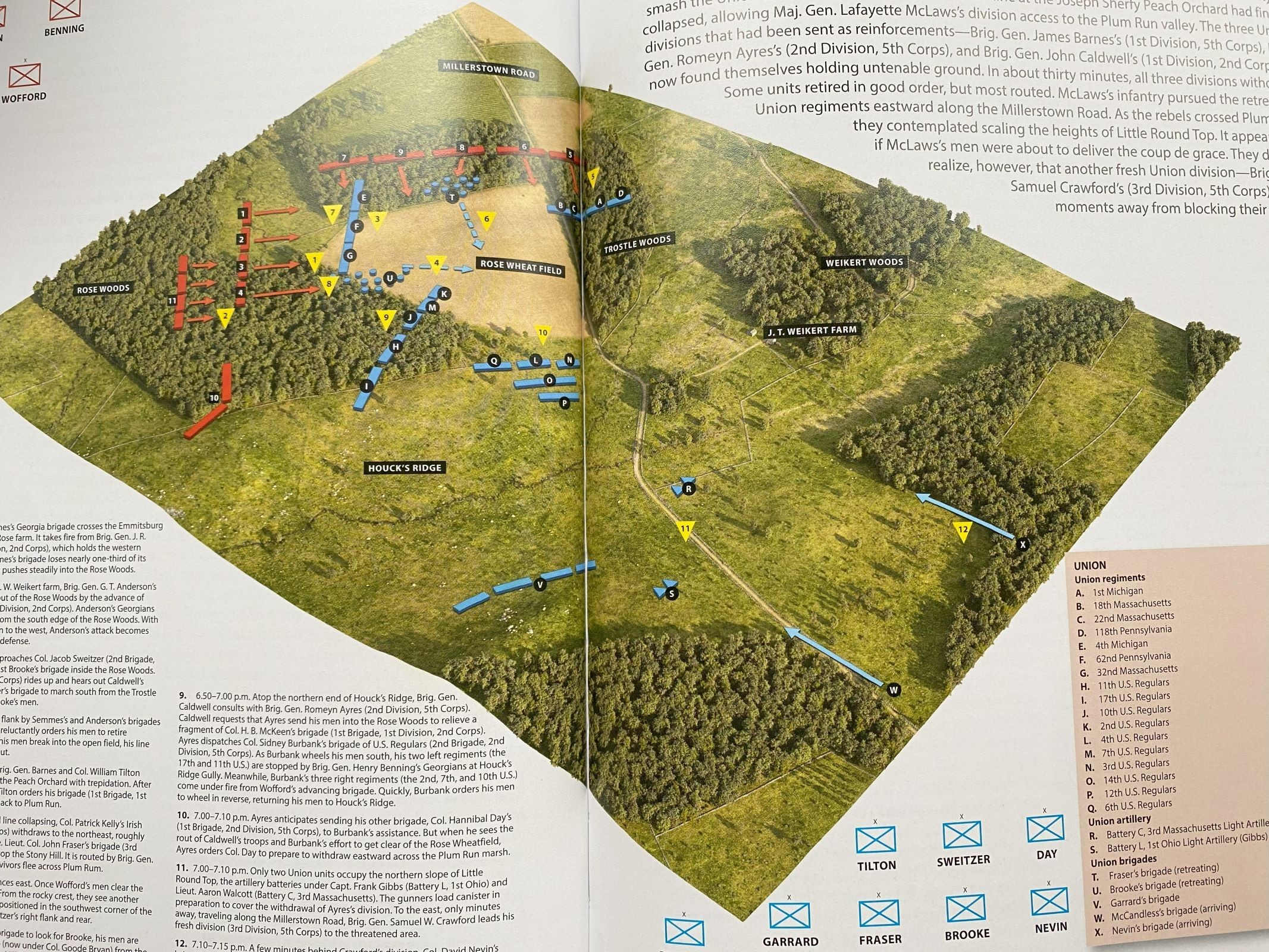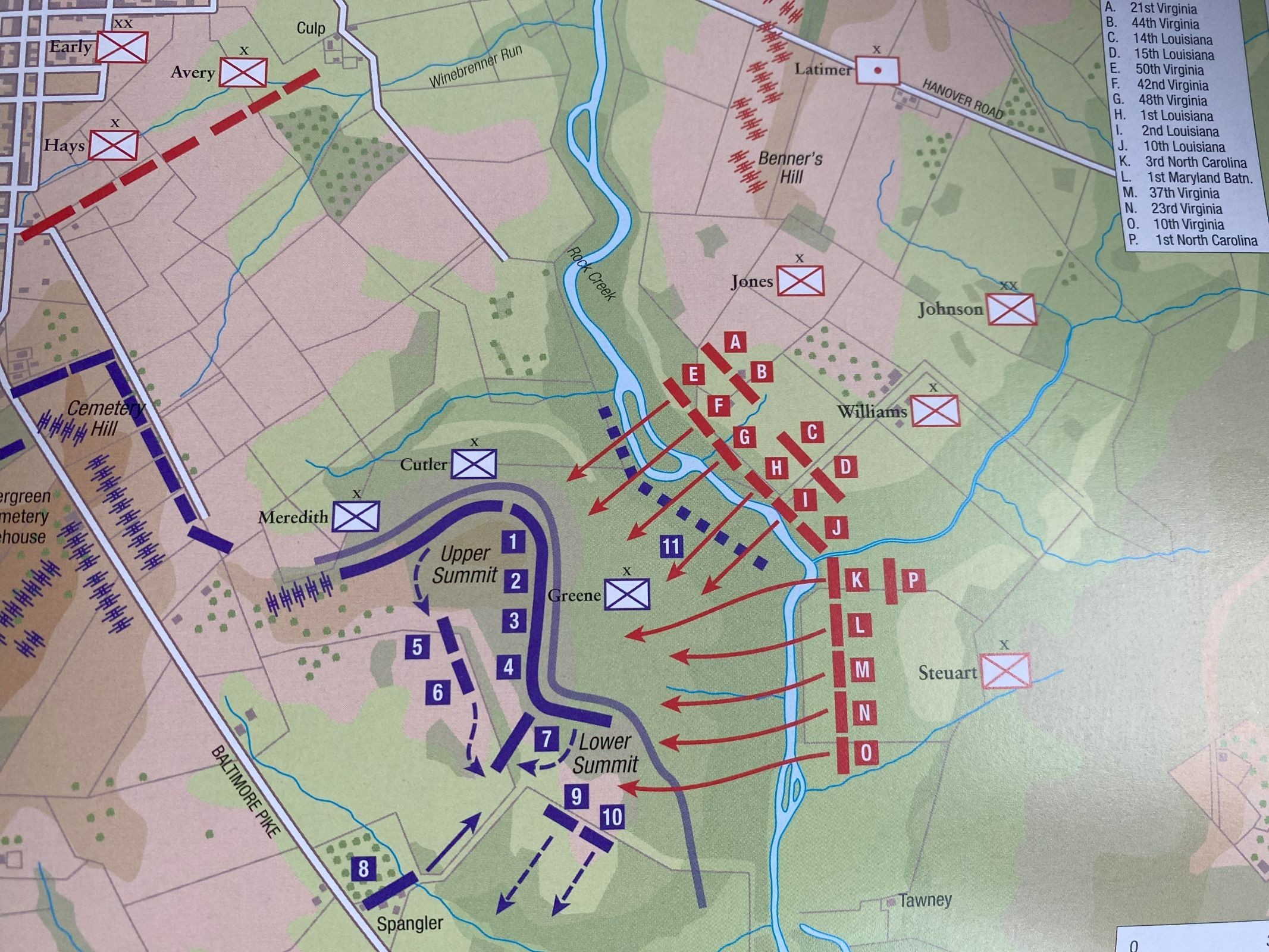In the Spring of 1863, the Confederate States of America were in the midst of an enormous paradox: while their most-dynamic field commander, General Robert E. Lee, seemed to own the battlefields of the Atlantic Coast of the Eastern United States, the Union blockade of their ports by the US Navy and the imminent fall of Vicksburg, their last fortification on the Mississippi River, seemed to portend the struggle for secession would eventually fail. Despite repeated victories in the field, the South was unable to prevent the North from slowly strangling it. Something drastic and dramatic needed to happen, and the decision was made for Lee to invade the North for a second time.
As Lee's Army of Northern Virginia was striking out for the border of Pennsylvania, the Union's Army of the Potomac was undergoing yet another paroxysm of command chaos. Having replaced its previous commander (Hooker) with the effective, but self-effacing George Gordon Meade, President Lincoln was seeking someone who could both protect Washington and Baltimore, AND whip the Rebels on the battlefield. With only days as commander, Meade was informed Lee's army had left Virginia for points north, leaving him with the urgent task of finding the enemy, then engaging him without risking another defeat like had happened at Chancellorsville only weeks before.
As it turned out, Lee was groping along as well, his cavalry having gone off on another ride around the Union army. By accident, the two armies stumbled into one another at Gettysburg, a small college town where at least five major roads joined. Even though neither commander wanted a major engagement there, from July 1st to July 3rd 1863, the two sides ended up fighting the biggest battle of the Civil War. When it was over, the overall defeat of the South was almost certain (ironically, Vicksburg surrendered the following day). But it took three days and upwards of 50,000 casualties to decide the outcome. Following the first day's fighting, it looked as though the Confederacy would defeat the Union once again, and the northern commander Meade was faced with deciding whether to withdraw or stay and continue the battle. The proper course of action was unclear: the First Day resulted in the loss of two corps, but by that evening, the Union troops had fallen back to a small hill outside of town and along a low ridge that ran southwards. Meade stayed, and Lee resolved to attack him once more on July 2nd. Both sides hurriedly brought up reinforcements to prepare for what many would consider to be the most-important part of the battle: Day Two.
Osprey Publications has released a 96-page volume of text, color plates, extensive maps, period photos and a detailed Order of Battle authored by Dr. Timothy J. Orr, professor of military history at Old Dominion University. The illustrator is Steve Noon.
The book opens with an explanation of where things stand following Day One: the South, having gotten reinforcements to Gettysburg faster than the Union, has crushed two corps, and ends the day in possession of the town, its lines bending around two sides of the Union position. The North, almost by default, has perched atop Cemetery Hill behind the town and along Cemetery Ridge running south towards two large hills (Round Top and Little Round Top). Reinforcements are finally pouring in, and the Union commander, George Meade, is confident after assessing his troops and the terrain that he can fight a defensive battle waiting for Lee to attack him. But as war teaches us, the best laid plans....
General Lee instructs his right wing commander, James Longstreet, to assault the Union left. Throughout the Second Day, the South falls upon the Union positions near the two Round Tops. Meade's placement of his forces is nearly upended by the bone-head move of General Dan Sickles of the Union Third Corps, who advances out beyond his supporting troops and exposes the entire Union flank to turning. Finally, after a titanic struggle in places now famous like The Wheat Field, Devil's Den and The Peach Orchard, the Confederate attack falters and the Union once more is secure along its lines.
The Third Day of the battle will see the famous (and doomed) attack on the Union center by Gen. George Pickett, but for all intents and purposes, the Second Day has determined that the South cannot win the battle of Gettysburg, and the "decisive" engagement Lee was seeking will instead be a Confederate tactical defeat. He will retreat to Virginia, where the two sides endure another two years of bloodshed.
Professor Orr has done a fine job of incorporating the latest historiography into the book, avoiding many of the "junk history" simplifications, such as that Col. Joshua Chamberlain and his 20th Maine "saved" the Union left flank, or that Meade was cowardly and wanted to withdraw his forces from Gettysburg and reestablish his lines along Pipe Creek in Maryland. In actuality, the 20th Maine was only one of several heroic units, including the 1st Minnesota, that performed yeoman duty on July 2nd. And Meade, while cautious, moved his forces around the battlefield with both skill and luck, ultimately fulfilling his assignment to "protect Washington and Baltimore, and engage the enemy."
The book has an hour-by-hour telling of the major events of the battle, including excellent maps that explain the flow of Longstreet's attack and the means the Union employed to blunt its force. The contents are:
THE END OF DAY ONE
ORDERS OF BATTLE
OPPOSING PLANS (what Lee and Meade wanted to accomplish)
Union plans
Confederate plans
THE SECOND DAY
Hunterstown and Benner's Hill (lesser-known components of the action that impacted the outcome)
The Confederate Advance
Little Round Top (important, but not the "all or nothing" that has been portrayed in film)
Devil's Den
The Rose Wheat Field
The Valley of Death (appropriately-named with over 6,000 casualties)
The Peach Orchard (the Dan Sickles ultimate sighting)
Cemetery Ridge (the quick thinking of Hancock and others saves the Union middle)
Culp's Hill (how the South almost won the battle of Gettysburg)
Cemetery Hill (the South might have turned Meade's flank if they had attacked with more men)
NIGHTFALL (the action peters out as darkness prevents further attacks)
BIBLIOGRAPHY
INDEX
The details are expansive without being overwhelming or boring, and overall this is both a crackerjack introduction to the battle for someone who lacks a strong foundation in the events of the three-day battle, and a stimulating and enjoyable supplement for those like myself who have immersed themselves in Gettysburg history.
Be sure to mention that you saw the book reviewed on Kitmaker Network when ordering your copy.





























